 Search by Keyword
Sign Up Below for our MONTHLY BEATLES TRIVIA QUIZ!
|
“DAY TRIPPER”
(John Lennon – Paul McCartney)
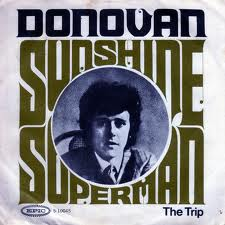 One aspect of composing music that John and Paul instinctively learned early on, and improved upon as time progressed, was making the perfect choice for the title of a song. “What it’s all about, regardless of eventual use, is the imagery that the title conveys,” Mark Stefani explains, adding “it immediately conjures up a vision of what the substance of that project will be.” For instance, imagine picking up a new release and looking at record titles with generic names such as “I Love You” or “Be True To Me.” They probably wouldn’t create much curiosity for hearing the song and you’d probably put it back down. However, a title such as “Sunshine Superman,” “Daydream Believer” or “Get Off My Cloud” might pique your interest enough to purchase it. One aspect of composing music that John and Paul instinctively learned early on, and improved upon as time progressed, was making the perfect choice for the title of a song. “What it’s all about, regardless of eventual use, is the imagery that the title conveys,” Mark Stefani explains, adding “it immediately conjures up a vision of what the substance of that project will be.” For instance, imagine picking up a new release and looking at record titles with generic names such as “I Love You” or “Be True To Me.” They probably wouldn’t create much curiosity for hearing the song and you’d probably put it back down. However, a title such as “Sunshine Superman,” “Daydream Believer” or “Get Off My Cloud” might pique your interest enough to purchase it.
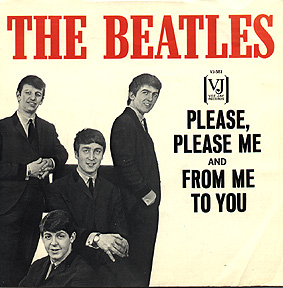 “Please Please Me” is one good example of The Beatles knowing how to incorporate a play on words, creating enough curiosity to land them their first chart topper in Britain. Both “Can’t Buy Me Love” and “A Hard Day’s Night” continued this trend. The group would eventually even delve into unknown territory, most record buyers wondering what exactly a “Ticket To Ride” was anyway. “Please Please Me” is one good example of The Beatles knowing how to incorporate a play on words, creating enough curiosity to land them their first chart topper in Britain. Both “Can’t Buy Me Love” and “A Hard Day’s Night” continued this trend. The group would eventually even delve into unknown territory, most record buyers wondering what exactly a “Ticket To Ride” was anyway.
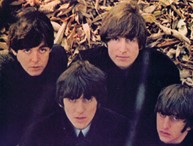 This unknown territory was solidified even further with the December 1965 release of “Day Tripper,” a title that left most enthusiasts scratching their heads. But with the undeniable drive of the winding repetitive guitar riff that propelled the recording along with their trademark Beatles harmonies, the song's mysterious subject matter just added to its allure. While most parents were suspicious (their suspicions probably correct) their kids didn’t really care. This unknown territory was solidified even further with the December 1965 release of “Day Tripper,” a title that left most enthusiasts scratching their heads. But with the undeniable drive of the winding repetitive guitar riff that propelled the recording along with their trademark Beatles harmonies, the song's mysterious subject matter just added to its allure. While most parents were suspicious (their suspicions probably correct) their kids didn’t really care.
Songwriting History
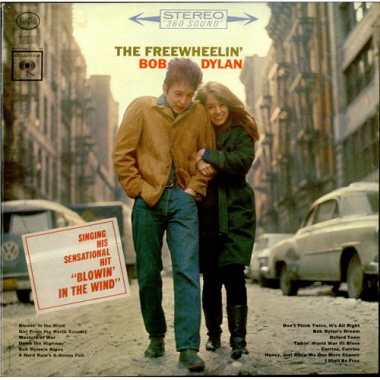 “Day Tripper” was a subject John Lennon talked about much in interviews, comments that give us a good amount of detail regarding its writing. In 1969 Lennon stated: “’Day Tripper’ was (written) under complete pressure, based on an old folk song I wrote about a month previous. It was very hard going, that, and it sounds it.” Since the song was recorded in October of 1965, its genesis must have begun in September of that year as written entirely by John. The mention of it deriving from a “folk song” suggests it as another attempt at mimicking Bob Dylan, at least in its early incarnation. The “pressure” was probably due to this being an attempt at writing their next single, which both John and Paul admitted in a 1966 interview that the composition was "forced." In the 2023 paperback edition of McCartney's book "The Lyrics," Paul explains about composing "Day Tripper," "The song is extremely economical and, if I remember correctly, written and recorded quickly in time for a Christmas release." “Day Tripper” was a subject John Lennon talked about much in interviews, comments that give us a good amount of detail regarding its writing. In 1969 Lennon stated: “’Day Tripper’ was (written) under complete pressure, based on an old folk song I wrote about a month previous. It was very hard going, that, and it sounds it.” Since the song was recorded in October of 1965, its genesis must have begun in September of that year as written entirely by John. The mention of it deriving from a “folk song” suggests it as another attempt at mimicking Bob Dylan, at least in its early incarnation. The “pressure” was probably due to this being an attempt at writing their next single, which both John and Paul admitted in a 1966 interview that the composition was "forced." In the 2023 paperback edition of McCartney's book "The Lyrics," Paul explains about composing "Day Tripper," "The song is extremely economical and, if I remember correctly, written and recorded quickly in time for a Christmas release."
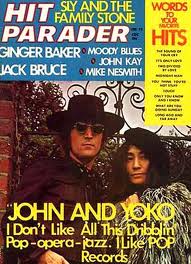 While John Lennon appeared to claim sole authorship in 1969, he continued to change his tune in later interviews. To Hit Parader magazine in 1972, his response to who wrote this song was: "Me, but I think Paul helped with the verse." To Playboy magazine in 1980, he reversed the story, saying, "Mine. Clearly. The lick, the guitar break and the whole bit." In his book "The Lyrics," Paul gives these details: "John or George wrote the opening guitar riff, and I think it was influenced by the American soul records were were listening to.” While John Lennon appeared to claim sole authorship in 1969, he continued to change his tune in later interviews. To Hit Parader magazine in 1972, his response to who wrote this song was: "Me, but I think Paul helped with the verse." To Playboy magazine in 1980, he reversed the story, saying, "Mine. Clearly. The lick, the guitar break and the whole bit." In his book "The Lyrics," Paul gives these details: "John or George wrote the opening guitar riff, and I think it was influenced by the American soul records were were listening to.”
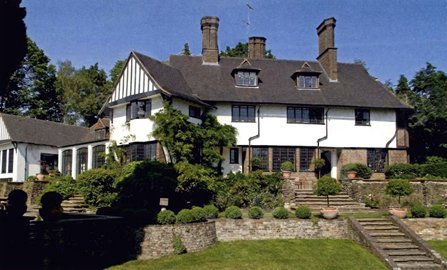 Paul McCartney and Barry Miles’ book “Many Years From Now” sheds some more interesting light on the composing of the song. After Barry Miles describes “Day Tripper” as “co-written in October 1965 at (John’s home in) Kenwood,” McCartney relates the following: “That was a co-written effort; we were both there making it all up but I would give John the main credit. Probably the idea came from John because he sang the lead, but it was a close thing. We both put a lot of work in on it.” Paul McCartney and Barry Miles’ book “Many Years From Now” sheds some more interesting light on the composing of the song. After Barry Miles describes “Day Tripper” as “co-written in October 1965 at (John’s home in) Kenwood,” McCartney relates the following: “That was a co-written effort; we were both there making it all up but I would give John the main credit. Probably the idea came from John because he sang the lead, but it was a close thing. We both put a lot of work in on it.”
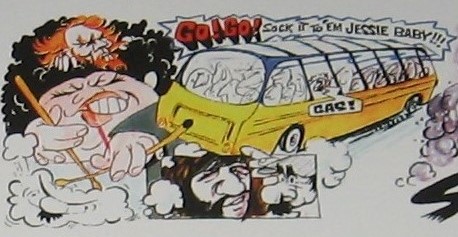 McCartney gives much detail as to what an actual "day trip" was in his 2023 editon of "The Lyrics." "When I was growing up, the cost of a plane ticket was prohibitive, well beyond our budget so a 'day trip' was much more likely for us. Wealthy people might go to the seaside for for a week or two and live it up in a hotel or boarding house, but people like us would mostly just go off somewhere for the day. The idea for the day trip was something that had a new lease of life after the Second World War. It was a way of having a break. An inexpensive holiday. If you didn't have enough time or money, you just went out for the day and it often involved a charabanc, the old term for a bus or coach. You'd all get on that and go for a trip...So, the day trip was all about the quick hit. Take the kids to a seasidey place, get some ozone down their throats." This very familiar "day trip" experience of McCartney's youth surfaced again later in The Beatles' "Magical Mystery Tour" song and film. McCartney gives much detail as to what an actual "day trip" was in his 2023 editon of "The Lyrics." "When I was growing up, the cost of a plane ticket was prohibitive, well beyond our budget so a 'day trip' was much more likely for us. Wealthy people might go to the seaside for for a week or two and live it up in a hotel or boarding house, but people like us would mostly just go off somewhere for the day. The idea for the day trip was something that had a new lease of life after the Second World War. It was a way of having a break. An inexpensive holiday. If you didn't have enough time or money, you just went out for the day and it often involved a charabanc, the old term for a bus or coach. You'd all get on that and go for a trip...So, the day trip was all about the quick hit. Take the kids to a seasidey place, get some ozone down their throats." This very familiar "day trip" experience of McCartney's youth surfaced again later in The Beatles' "Magical Mystery Tour" song and film.
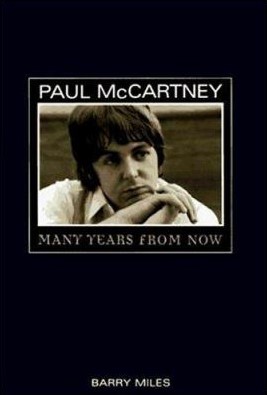 In reference to sexual connotations contained in the song, Paul continues in "Many Years From Now," "We thought, ‘That’d be fun to put in. That was one of the great things about collaborating; you could nudge-nudge, wink-wink a bit, whereas if you’re sitting on your own, you might not put it in. You know, ‘I’d love to turn you on,’ we literally looked at each other like, ‘Oh, dare we do this?’ It was a good moment; there was always good eye contact when we would put those things in." In reference to sexual connotations contained in the song, Paul continues in "Many Years From Now," "We thought, ‘That’d be fun to put in. That was one of the great things about collaborating; you could nudge-nudge, wink-wink a bit, whereas if you’re sitting on your own, you might not put it in. You know, ‘I’d love to turn you on,’ we literally looked at each other like, ‘Oh, dare we do this?’ It was a good moment; there was always good eye contact when we would put those things in."
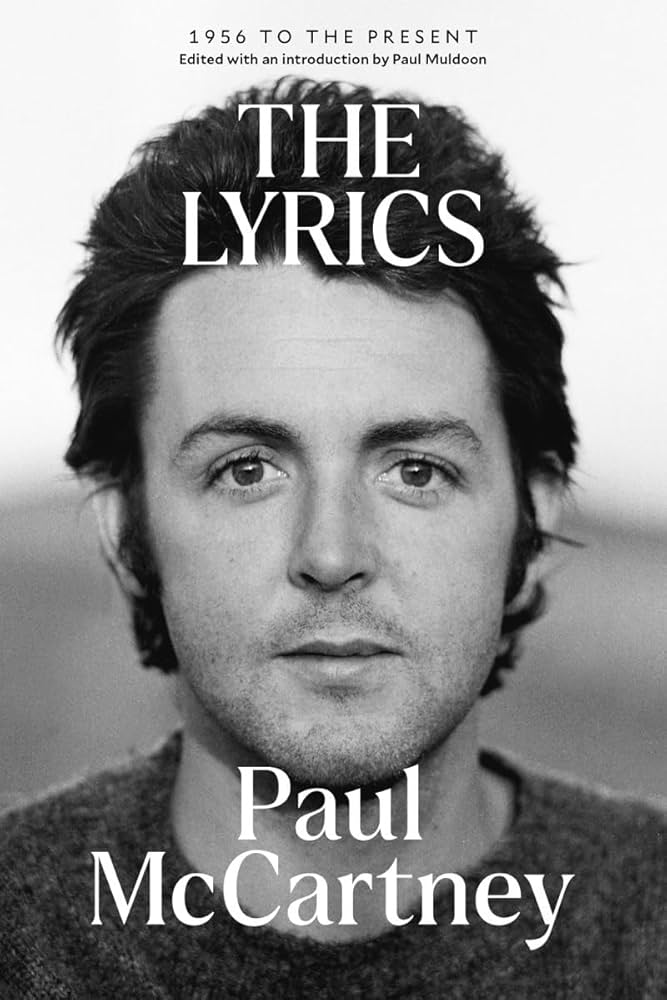 In "The Lyrics," Paul elaborates further, detailing one of the sexual inuendos contained in "Day Tripper." "That sauciness was really part of the lifeblood of the country. Back in those days, people were not squeamish about having a joke that might nowadays be considered really inappropriate, off-color, blue. And some of this risque hinterland finds its way into 'Day Tripper.' I think of the innuendo of 'half the way there.'...This was our lives. Like many young men, you'd go to the cinema on a date with a girl and you'd be trying to 'make out,' as Americans say. That was the whole point. It really wasn't a conversational evening. It was conversation leading to your possibly being allowed to get your hands on a girl's breast. That would be the ideal...I have heard people in America talking about getting to first base, then to second base. The baseball allusion. So this would be, 'she took me to second base,' while you're really dreaming of getting the home run." In "The Lyrics," Paul elaborates further, detailing one of the sexual inuendos contained in "Day Tripper." "That sauciness was really part of the lifeblood of the country. Back in those days, people were not squeamish about having a joke that might nowadays be considered really inappropriate, off-color, blue. And some of this risque hinterland finds its way into 'Day Tripper.' I think of the innuendo of 'half the way there.'...This was our lives. Like many young men, you'd go to the cinema on a date with a girl and you'd be trying to 'make out,' as Americans say. That was the whole point. It really wasn't a conversational evening. It was conversation leading to your possibly being allowed to get your hands on a girl's breast. That would be the ideal...I have heard people in America talking about getting to first base, then to second base. The baseball allusion. So this would be, 'she took me to second base,' while you're really dreaming of getting the home run."
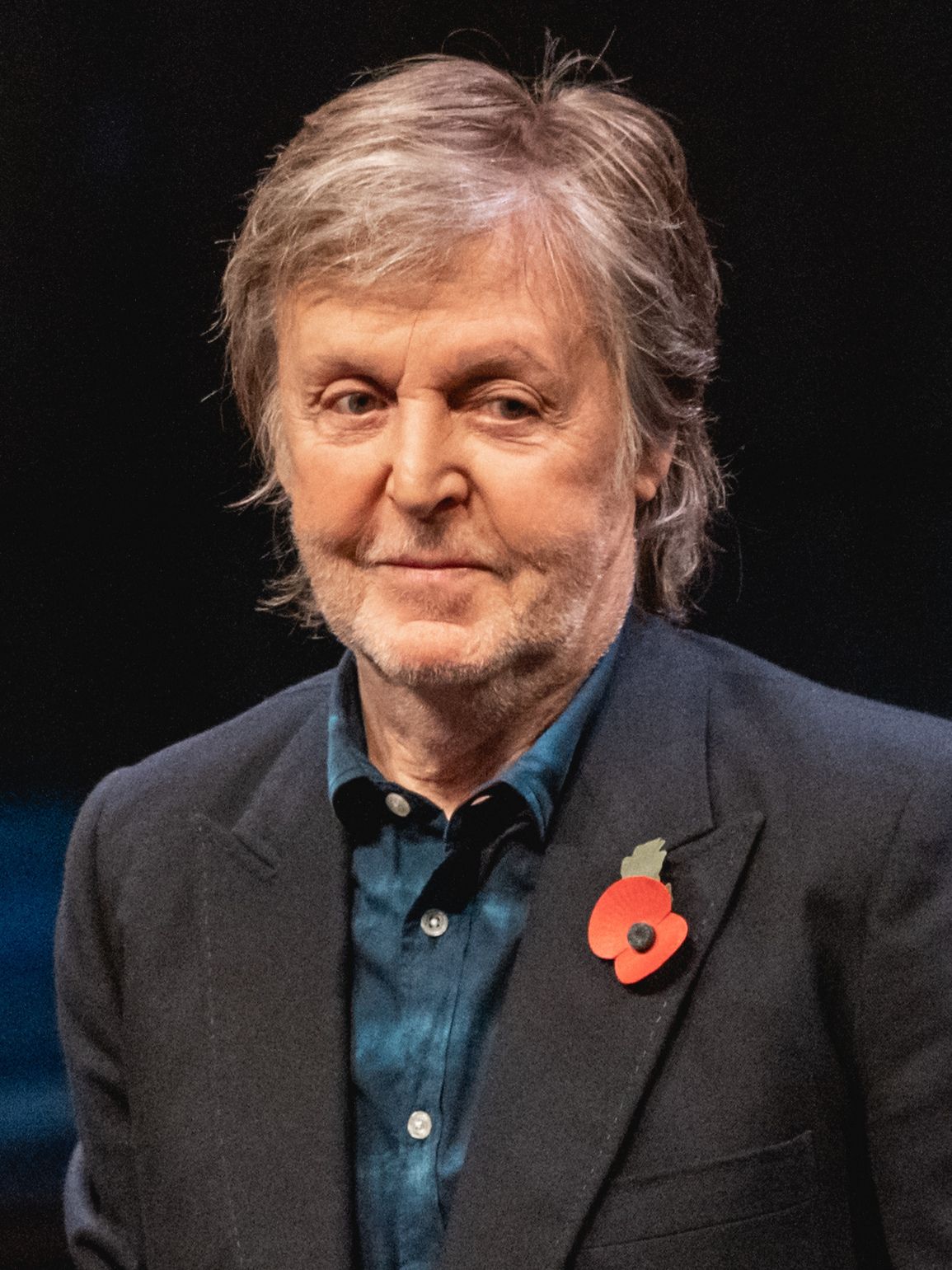 Paul then details additional sexual references found in "Day Tripper" in his book "The Lyrics." "We'd sing 'she's a big teaser,' but what me mean is 'she's a prick teaser.' Our friends would know that was what we meant. The BBC might not. In the UK, the BBC was known as 'Auntie' - from its 'Auntie knows best' refrained and refined outlook, compared to the more garish and commercial channel ITV. So, the prudish BBC would hear 'big teaser,' and we'd get away with it...Then there's the direct reference to a 'one-night stand.' It's about sex, of course. But it also refers to the music world - a show that ran for one night only." Paul then details additional sexual references found in "Day Tripper" in his book "The Lyrics." "We'd sing 'she's a big teaser,' but what me mean is 'she's a prick teaser.' Our friends would know that was what we meant. The BBC might not. In the UK, the BBC was known as 'Auntie' - from its 'Auntie knows best' refrained and refined outlook, compared to the more garish and commercial channel ITV. So, the prudish BBC would hear 'big teaser,' and we'd get away with it...Then there's the direct reference to a 'one-night stand.' It's about sex, of course. But it also refers to the music world - a show that ran for one night only."
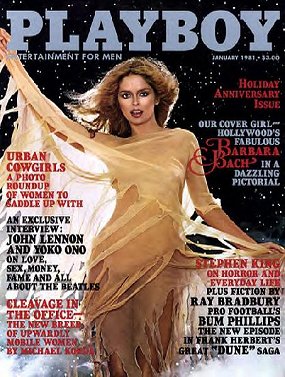 Lennon explained in 1970 about the drug connotations that were also intended in the lyrics of in the song.: “It wasn’t a serious message song. It was a drug song. In a way, it was a day tripper. I just liked the word...I’ve always needed a drug to survive. The (other Beatles) too, but I always had more, I always took more pills and more of everything, ‘cause I’m more crazy.” In his 1980 Playboy interview, he adds: “It’s just a rock’n’roll song. Day trippers are people who go on day trips, right? Usually on a ferryboat, or something. But the song was, kind of, ‘You’re a weekend hippie.’ Get it?” Lennon explained in 1970 about the drug connotations that were also intended in the lyrics of in the song.: “It wasn’t a serious message song. It was a drug song. In a way, it was a day tripper. I just liked the word...I’ve always needed a drug to survive. The (other Beatles) too, but I always had more, I always took more pills and more of everything, ‘cause I’m more crazy.” In his 1980 Playboy interview, he adds: “It’s just a rock’n’roll song. Day trippers are people who go on day trips, right? Usually on a ferryboat, or something. But the song was, kind of, ‘You’re a weekend hippie.’ Get it?”
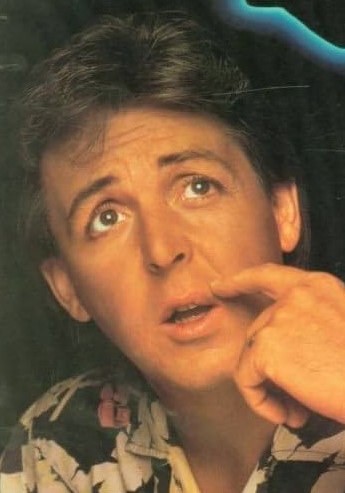 McCartney went on to explain in "Many Years From Now": "‘Day Tripper’ was to do with tripping. Acid was coming in on the scene, and often we’d do these songs about ‘the girl who thought she was it.’ Mainly the impetus for that used to come from John. I think John met quite a few girls who thought they were it and he was a bit up in arms about that kind of thing…But this was just a tongue-in-cheek song about someone who was a 'day tripper,' a Sunday painter, 'Sunday driver,' somebody who was committed only in part to the idea. Whereas we saw ourselves as full-time trippers, fully committed drivers, she was just 'a day tripper.'" McCartney went on to explain in "Many Years From Now": "‘Day Tripper’ was to do with tripping. Acid was coming in on the scene, and often we’d do these songs about ‘the girl who thought she was it.’ Mainly the impetus for that used to come from John. I think John met quite a few girls who thought they were it and he was a bit up in arms about that kind of thing…But this was just a tongue-in-cheek song about someone who was a 'day tripper,' a Sunday painter, 'Sunday driver,' somebody who was committed only in part to the idea. Whereas we saw ourselves as full-time trippers, fully committed drivers, she was just 'a day tripper.'"
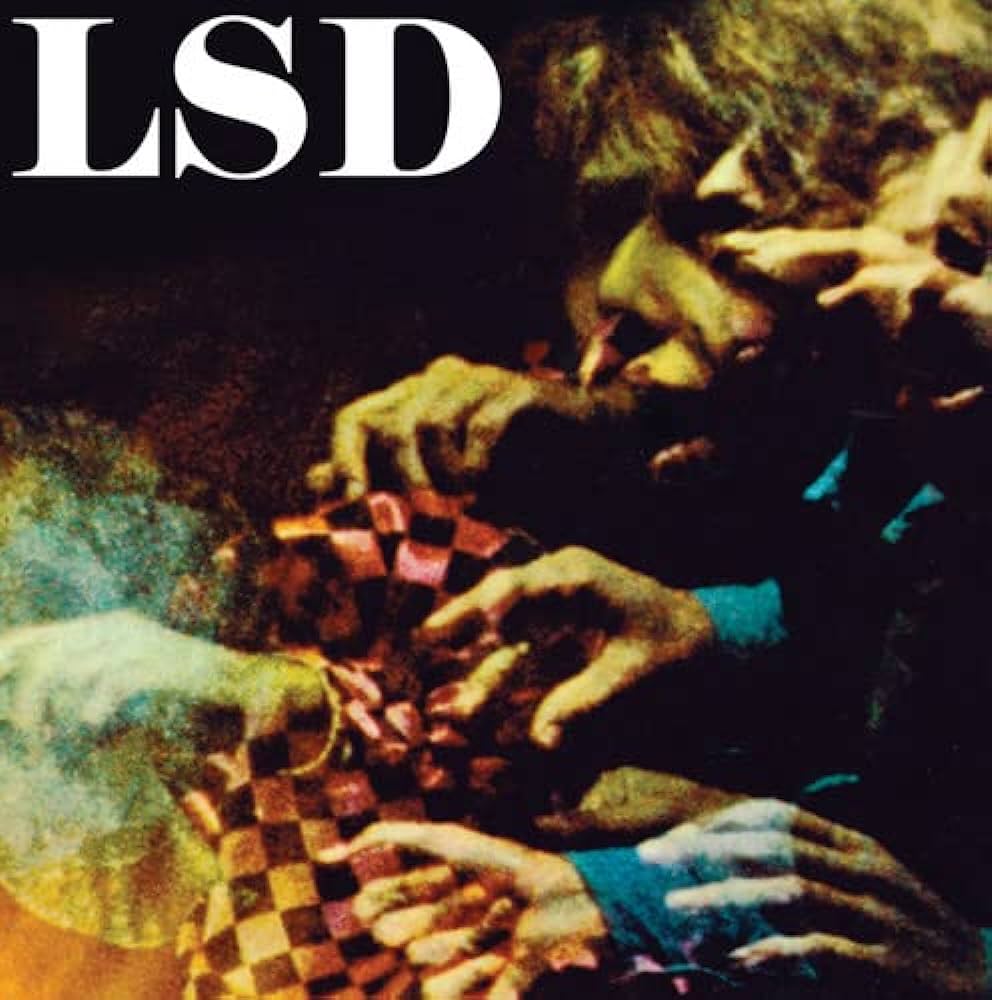 In "The Lyrics," McCartney adds: "This song dates from 1965, around the time that LSD appeared on the scene. We heard talk about it, and John and George tried it first courtesy of a dinner with a dentist friend. We were just in those early stages of experimenting with it. We always thought it was good to try to work contemporary stuff into songs. Again, it's a message to your friends. 'So this was a day tripper. You know, you'll know what I mean, boys. You know, 'one way ticket.' 'Took me so long to find out' and 'I found out.' A 'sunday driver' was someone who wasn't the full thing. You weren't getting the total pleasure of sex, or drugs, or these other new freedoms. You were just getting hints of it and 'taking the easy way out.'" In "The Lyrics," McCartney adds: "This song dates from 1965, around the time that LSD appeared on the scene. We heard talk about it, and John and George tried it first courtesy of a dinner with a dentist friend. We were just in those early stages of experimenting with it. We always thought it was good to try to work contemporary stuff into songs. Again, it's a message to your friends. 'So this was a day tripper. You know, you'll know what I mean, boys. You know, 'one way ticket.' 'Took me so long to find out' and 'I found out.' A 'sunday driver' was someone who wasn't the full thing. You weren't getting the total pleasure of sex, or drugs, or these other new freedoms. You were just getting hints of it and 'taking the easy way out.'"
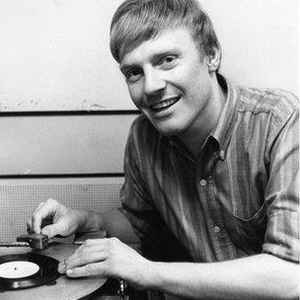 British DJ Chris Denning complained how German listeners were left "out of the loop," so to speak, as to what this title meant. “Several of my colleagues on the German language service of Radio Luxembourg wish The Beatles would give more care to choosing titles of their records. ‘Day Tripper,’ for example. ‘Tripper’ just happens to be the German word for a disease. How does one announce that?” British DJ Chris Denning complained how German listeners were left "out of the loop," so to speak, as to what this title meant. “Several of my colleagues on the German language service of Radio Luxembourg wish The Beatles would give more care to choosing titles of their records. ‘Day Tripper,’ for example. ‘Tripper’ just happens to be the German word for a disease. How does one announce that?”
Recording History
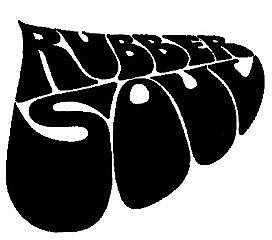 On October 16th, 1965, which was only the third day of recording for what became the “Rubber Soul” album, The Beatles along with guest Julia Baird (John’s half sister) entered EMI Studio Two at 2:30 pm for a nine-and-a-half hour recording session. The vast majority of this session, the first eight-and-a-half hours, was used to fully record the newly composed song “Day Tripper” which appears to have been slated as their upcoming December single. On October 16th, 1965, which was only the third day of recording for what became the “Rubber Soul” album, The Beatles along with guest Julia Baird (John’s half sister) entered EMI Studio Two at 2:30 pm for a nine-and-a-half hour recording session. The vast majority of this session, the first eight-and-a-half hours, was used to fully record the newly composed song “Day Tripper” which appears to have been slated as their upcoming December single.
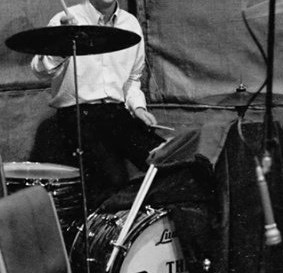 The first four-and-a-half hours were spent discussing and rehearsing the song’s intricate arrangement, which caused Julia Baird to comment, “It seemed like bits and pieces were being put together…I can’t understand how they got the final version.” After a good amount of time was spent putting these “bits and pieces” together, three takes of the rhythm track were recorded. The instrumentation here was George on lead guitar (the main riff), John on electric rhythm guitar, Paul on bass and Ringo on drums. The first four-and-a-half hours were spent discussing and rehearsing the song’s intricate arrangement, which caused Julia Baird to comment, “It seemed like bits and pieces were being put together…I can’t understand how they got the final version.” After a good amount of time was spent putting these “bits and pieces” together, three takes of the rhythm track were recorded. The instrumentation here was George on lead guitar (the main riff), John on electric rhythm guitar, Paul on bass and Ringo on drums.
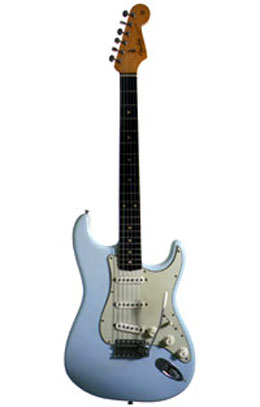 It should be noted here that, since Lennon once credited himself with “the lick, the guitar break, and the whole bit,” many feel he meant that he played the main guitar parts in the studio. However, all indications show that George played the guitar riff during the rhythm track as well as the overdub and also played the guitar solo in the bridge. John apparently meant that he was the writer of the guitar riff as well as the originator of the guitar break, or bridge, in the arrangement. During their live performances of the song, John is seen playing rhythm guitar as was his role during the recording of the rhythm track. It should be noted here that, since Lennon once credited himself with “the lick, the guitar break, and the whole bit,” many feel he meant that he played the main guitar parts in the studio. However, all indications show that George played the guitar riff during the rhythm track as well as the overdub and also played the guitar solo in the bridge. John apparently meant that he was the writer of the guitar riff as well as the originator of the guitar break, or bridge, in the arrangement. During their live performances of the song, John is seen playing rhythm guitar as was his role during the recording of the rhythm track.
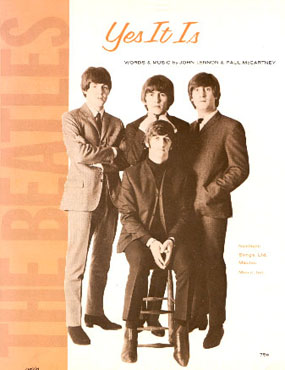 With Paul counting the song off, "take one" showed the entire arrangement details already in place although we do notice George flubbing a note in the guitar riff at the end of the ninth measure (something we occasionally note in the originally released version). However, there are some interesting differences in his guitar part, including a repeating quick-picking riff he plays during the second half of the second verse (which would have occurred after the words “day tripper” and then “ticket, yeah”), as well as his famous volume pedal during his ascending notes in the bridge (as used in the songs “Yes It Is,” “I Need You” and “Wait” earlier in the year). This take comes to a halt when John accidentally changes chords too early in the final verse, which was an easy mistake considering no vocals were recorded at this time and keeping count of measures would have been difficult. With Paul counting the song off, "take one" showed the entire arrangement details already in place although we do notice George flubbing a note in the guitar riff at the end of the ninth measure (something we occasionally note in the originally released version). However, there are some interesting differences in his guitar part, including a repeating quick-picking riff he plays during the second half of the second verse (which would have occurred after the words “day tripper” and then “ticket, yeah”), as well as his famous volume pedal during his ascending notes in the bridge (as used in the songs “Yes It Is,” “I Need You” and “Wait” earlier in the year). This take comes to a halt when John accidentally changes chords too early in the final verse, which was an easy mistake considering no vocals were recorded at this time and keeping count of measures would have been difficult.
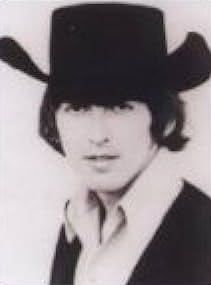 "Take two" ended because of the same problem, only the mistake was made early in the first verse. "Take three" was considered the best, although George did miss the same note of the guitar riff at the end of the first measure of the final verse. By this time it was 7 pm and time for overdubs. "Take two" ended because of the same problem, only the mistake was made early in the first verse. "Take three" was considered the best, although George did miss the same note of the guitar riff at the end of the first measure of the final verse. By this time it was 7 pm and time for overdubs.
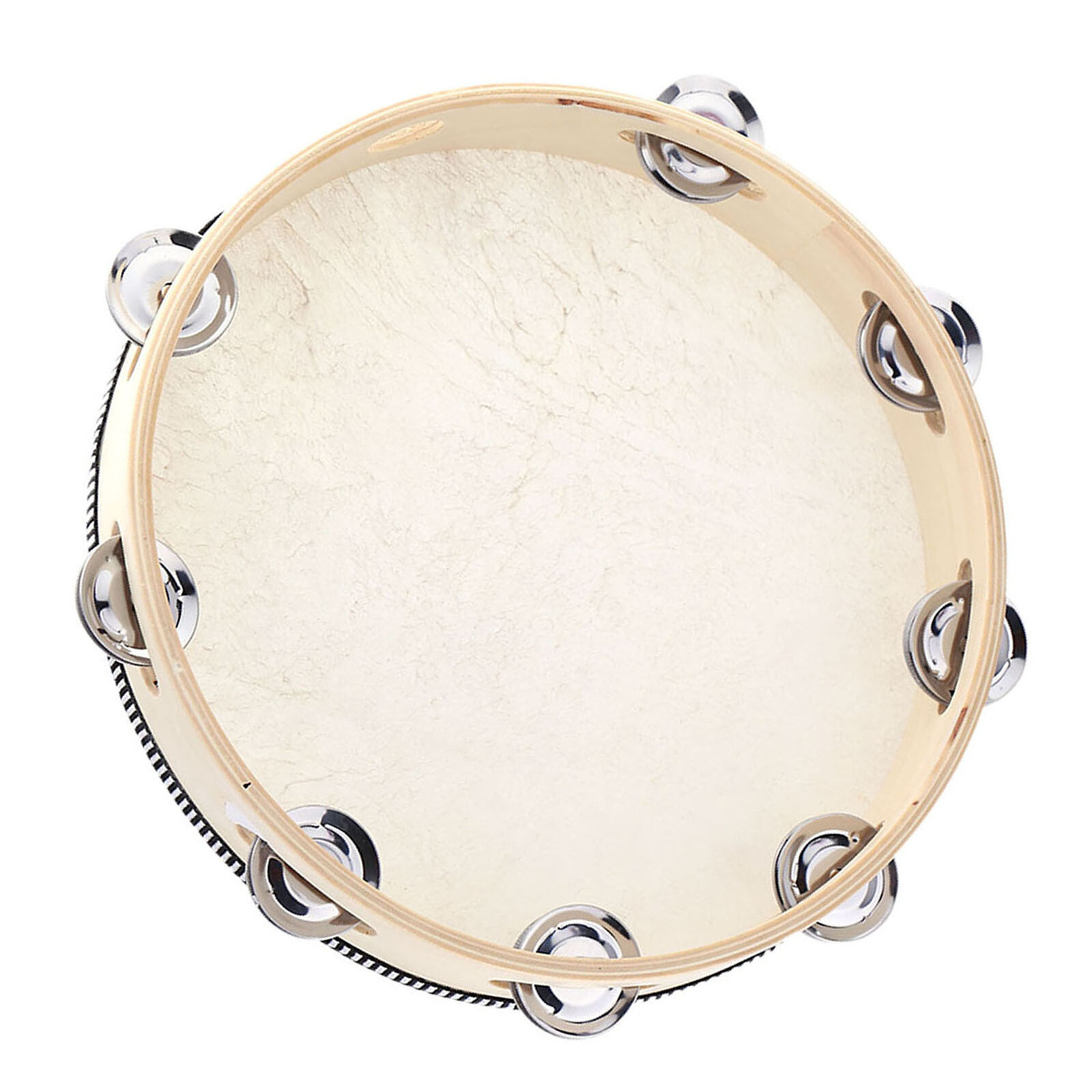 These overdubs consisted of both John and Paul’s lead vocals, which were then double-tracked along with a third harmony from George, and then George double-tracking the guitar riff heard throughout the song while also adding a solo in the bridge section as an additional overdub. A subtle vocal error was left in, however, John singing “one-day driver, yeah” instead of “Sunday driver,” no doubt a combination of the line “one way ticket” from the previous verses, him catching himself midway. While most attribute the tambourine overdub to Ringo, George himself sets the record straight in a 1965 interview: “’Day Tripper’ is a rocker, but not in the old-fashioned sense. It’s a very ‘Groupy’ sort of record. It starts with guitar, then bass guitar and then John comes in on tambourine. There’s a funny middle which stays on one chord.” The tambourine was also double-tracked in areas where dramatic shaking was deemed necessary. These overdubs consisted of both John and Paul’s lead vocals, which were then double-tracked along with a third harmony from George, and then George double-tracking the guitar riff heard throughout the song while also adding a solo in the bridge section as an additional overdub. A subtle vocal error was left in, however, John singing “one-day driver, yeah” instead of “Sunday driver,” no doubt a combination of the line “one way ticket” from the previous verses, him catching himself midway. While most attribute the tambourine overdub to Ringo, George himself sets the record straight in a 1965 interview: “’Day Tripper’ is a rocker, but not in the old-fashioned sense. It’s a very ‘Groupy’ sort of record. It starts with guitar, then bass guitar and then John comes in on tambourine. There’s a funny middle which stays on one chord.” The tambourine was also double-tracked in areas where dramatic shaking was deemed necessary.
 By about 11 pm the song was complete and they spent the last hour of the session on George’s new composition “If I Needed Someone,” which was completed on the following session two days later. By about 11 pm the song was complete and they spent the last hour of the session on George’s new composition “If I Needed Someone,” which was completed on the following session two days later.
The first mono mix of “Day Tripper” was created on October 25th, 1965, in the control room of EMI Studio Two by producer George Martin and engineers Norman Smith and Ken Scott. It is presumed that at this point they noticed a problem with the master tape which deemed this first mix unusable.
 The next day, October 26th, 1965, saw the first stereo mix of the song created in the control room of EMI Studio Two by George Martin, Norman Smith and 2nd engineer Ron Pender. The entire rhythm track is heard in the left channel throughout the mix except that the introductory guitar riff suddenly switches to the right channel when the other instruments come in. All of the overdubs are heard in the right channel, including all of the vocals. This stereo mix was issued in the US on their “Yesterday…And Today” album in 1966. The next day, October 26th, 1965, saw the first stereo mix of the song created in the control room of EMI Studio Two by George Martin, Norman Smith and 2nd engineer Ron Pender. The entire rhythm track is heard in the left channel throughout the mix except that the introductory guitar riff suddenly switches to the right channel when the other instruments come in. All of the overdubs are heard in the right channel, including all of the vocals. This stereo mix was issued in the US on their “Yesterday…And Today” album in 1966.
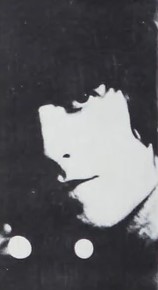 Effort was made on this stereo mix to disquise the problem previously found on the master tape, this being a noticeable squeaky click on the track containing George’s overdubbed guitar riff and John’s tambourine, an audible noise following thereafter. The click occurs just after the words “tried to please her” in the third verse, so the production team decided to cut that particular section out of the stereo mix entirely, leaving an obvious flaw in the finished product with both a guitar note and tambourine missing for a slight moment. This is repeated, although less noticeable, on the word “tried” at the start of the ninth measure of this same verse. Effort was made on this stereo mix to disquise the problem previously found on the master tape, this being a noticeable squeaky click on the track containing George’s overdubbed guitar riff and John’s tambourine, an audible noise following thereafter. The click occurs just after the words “tried to please her” in the third verse, so the production team decided to cut that particular section out of the stereo mix entirely, leaving an obvious flaw in the finished product with both a guitar note and tambourine missing for a slight moment. This is repeated, although less noticeable, on the word “tried” at the start of the ninth measure of this same verse.
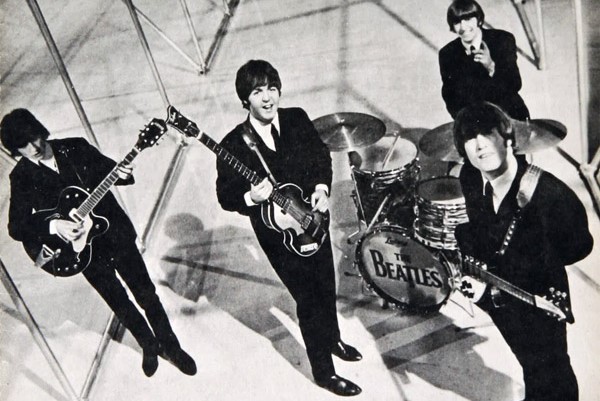 Two additional mono mixes were made on October 29th, 1965, also in the control room of EMI Studio Two by George Martin, Norman Smith and Ken Scott, one of which was made specifically for the upcoming British television special “The Music Of Lennon And McCartney,” the other being used as the official version for worldwide release as a single. The same fancy editing was used to mask the master take flaw, which was less noticeable in mono since there were two guitars playing the same riff heard only on one track in mono. Two additional mono mixes were made on October 29th, 1965, also in the control room of EMI Studio Two by George Martin, Norman Smith and Ken Scott, one of which was made specifically for the upcoming British television special “The Music Of Lennon And McCartney,” the other being used as the official version for worldwide release as a single. The same fancy editing was used to mask the master take flaw, which was less noticeable in mono since there were two guitars playing the same riff heard only on one track in mono.
 A segment of "Day Tripper," as recorded at one of their five performances at the Nippon Budokan Hall in Tokyo, Japan between June 30th and July 2nd, 1966, was reviewed by The Beatles in their Tokyo Hilton Hotel room afterwards. As caught on tape by Ringo's cassette recorder, after hearing a segment of this song, John asked manager Brian Epstein what he thought of the show. Ringo's cassette, along with two others from this 1966 international tour, fetched $16,000 in March of 2024 at an Omega auction in Newton-Le-Willows, Merseyside, England. A segment of "Day Tripper," as recorded at one of their five performances at the Nippon Budokan Hall in Tokyo, Japan between June 30th and July 2nd, 1966, was reviewed by The Beatles in their Tokyo Hilton Hotel room afterwards. As caught on tape by Ringo's cassette recorder, after hearing a segment of this song, John asked manager Brian Epstein what he thought of the show. Ringo's cassette, along with two others from this 1966 international tour, fetched $16,000 in March of 2024 at an Omega auction in Newton-Le-Willows, Merseyside, England.
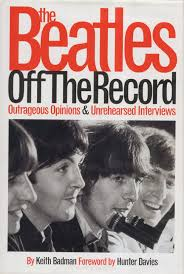 Interestingly, The Beatles' final live touring performance on August 29th, 1966 at Candlestick Park included the song, introduced by John as "the one about the naughty lady called 'Day Tripper.'" As detailed in Keith Badman's book "The Beatles Off The Record," the group's press officer Tony Barrow recalls: "There was a sort of end of term spirit thing going on, and there was also this kind of feeling amongst all of us around The Beatles, that this might just be the last concert that they will ever do. I remember Paul, casually, at the very last minute, saying, 'Have you got your cassette recorder with you?' and I said, 'Yes, of course.' Paul then said, 'Tape it, will you? Tape the show,' which I did, literally just holding the microphone up in the middle of the field. As a personal souvenir of the occasion, it was a very nice thing to have." Even though Tony Barrow insists that he only made one copy of the tape, which he had locked in a drawer in his London office, and gave the original to Paul, this recording has been available on bootleg releases throughout the years. Interestingly, The Beatles' final live touring performance on August 29th, 1966 at Candlestick Park included the song, introduced by John as "the one about the naughty lady called 'Day Tripper.'" As detailed in Keith Badman's book "The Beatles Off The Record," the group's press officer Tony Barrow recalls: "There was a sort of end of term spirit thing going on, and there was also this kind of feeling amongst all of us around The Beatles, that this might just be the last concert that they will ever do. I remember Paul, casually, at the very last minute, saying, 'Have you got your cassette recorder with you?' and I said, 'Yes, of course.' Paul then said, 'Tape it, will you? Tape the show,' which I did, literally just holding the microphone up in the middle of the field. As a personal souvenir of the occasion, it was a very nice thing to have." Even though Tony Barrow insists that he only made one copy of the tape, which he had locked in a drawer in his London office, and gave the original to Paul, this recording has been available on bootleg releases throughout the years.
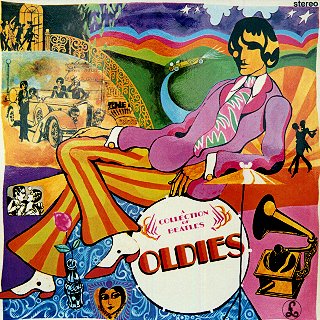 Because EMI staff thought the October 26th, 1965 stereo mix could be improved upon, a further stereo mix was created on November 10th, 1966 in preparation for the upcoming British compilation album “A Collection Of Beatles Oldies.” This mix was made in Room 65 of EMI Studios by engineers Peter Bown and Graham Kirkby with no producer required. Because EMI staff thought the October 26th, 1965 stereo mix could be improved upon, a further stereo mix was created on November 10th, 1966 in preparation for the upcoming British compilation album “A Collection Of Beatles Oldies.” This mix was made in Room 65 of EMI Studios by engineers Peter Bown and Graham Kirkby with no producer required.
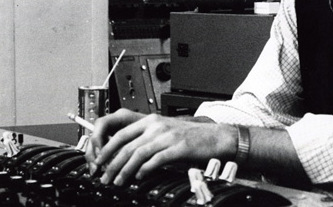 This new mix was by-and-large the same as the previous stereo mix, still containing the small missing moments during the final verse to mask the master tape defect. A similar alteration was made in the conclusion of the song as well. John and Paul intended for the vocals to alternate between “day tripper” and “day tripper, yeah” as the song faded out. However, since John inadvertently sang “yeah” the first time around, they must have informed the EMI staff of their mistake and they tried to cut it out of this new mix in the same way they cut out the master tape flaw. The results, though, were less than perfect, the work put into omitting the error probably not worth the effort. Slightly more reverb is also heard on the vocals, the result of which is mostly noticeable on the left channel. This new mix was by-and-large the same as the previous stereo mix, still containing the small missing moments during the final verse to mask the master tape defect. A similar alteration was made in the conclusion of the song as well. John and Paul intended for the vocals to alternate between “day tripper” and “day tripper, yeah” as the song faded out. However, since John inadvertently sang “yeah” the first time around, they must have informed the EMI staff of their mistake and they tried to cut it out of this new mix in the same way they cut out the master tape flaw. The results, though, were less than perfect, the work put into omitting the error probably not worth the effort. Slightly more reverb is also heard on the vocals, the result of which is mostly noticeable on the left channel.
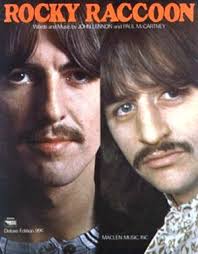 The Beatles, that is to say McCartney, touched on the song once more in the studio on August 15th, 1968. While they were recording the rhythm track for "Rocky Raccoon," Paul got lost while doing an adlib for the verse about "the doctor" on "take four." Paul stopped the song saying, 'F*uck knows where I am," before picking out the riff of "Day Tripper" to releive the tension. This, of course, has never been released. The Beatles, that is to say McCartney, touched on the song once more in the studio on August 15th, 1968. While they were recording the rhythm track for "Rocky Raccoon," Paul got lost while doing an adlib for the verse about "the doctor" on "take four." Paul stopped the song saying, 'F*uck knows where I am," before picking out the riff of "Day Tripper" to releive the tension. This, of course, has never been released.
 Sometime in 2015, Giles Martin (son of George Martin) and Sam Okell returned to the original master tape to create a more vibrant stereo mix at Abbey Road Studios, the result included on the re-released compilation album "Beatles 1." Then again in 2023, Giles Martin was given the task of creating a "demix remix" of "Day Tripper" for inclusion on the 50th Anniversary edition of the compilation album "The Beatles / 1962 - 1966" (aka "The Red Album"). With Peter Jackson's AI technology at his disposal, Giles Martin was able to utilize this "new machine-learning techology" so that many "individual elements that were put to tape...and were therefore impossible to separate" could be "untangled, allowing Giles (Martin) to put the original recordings back together with even greater clarity and impact," as stated by John Harris in the liner notes of the above mentioned album. With John's rhythm guitar and tambourine panned somewhat to the right channel and with more centered vocals, this excellent new mix is arbuably the best "Day Tripper" listening experience yet. Sometime in 2015, Giles Martin (son of George Martin) and Sam Okell returned to the original master tape to create a more vibrant stereo mix at Abbey Road Studios, the result included on the re-released compilation album "Beatles 1." Then again in 2023, Giles Martin was given the task of creating a "demix remix" of "Day Tripper" for inclusion on the 50th Anniversary edition of the compilation album "The Beatles / 1962 - 1966" (aka "The Red Album"). With Peter Jackson's AI technology at his disposal, Giles Martin was able to utilize this "new machine-learning techology" so that many "individual elements that were put to tape...and were therefore impossible to separate" could be "untangled, allowing Giles (Martin) to put the original recordings back together with even greater clarity and impact," as stated by John Harris in the liner notes of the above mentioned album. With John's rhythm guitar and tambourine panned somewhat to the right channel and with more centered vocals, this excellent new mix is arbuably the best "Day Tripper" listening experience yet.
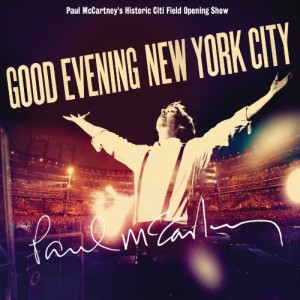 On July 17th, 18th and 21st, 2009, Paul McCartney and band performed shows at the newly constructed Citi Field in New York City. On one of these nights, a recording was made of their performance of “Day Tripper,” which was included on Paul’s live album “Good Evening New York City.” On July 17th, 18th and 21st, 2009, Paul McCartney and band performed shows at the newly constructed Citi Field in New York City. On one of these nights, a recording was made of their performance of “Day Tripper,” which was included on Paul’s live album “Good Evening New York City.”
Song Structure and Style
This “’groupy’ sort of record,” as George Harrison called it, definitely breaks new ground for The Beatles, structure- and arrangement-wise. While its format is of a usual ‘verse/ verse/ bridge/ verse’ nature (or aaba) that isn’t repeated (used as early as “Please Please Me”), many dramatic differences make it distinctively different from anything they had done up to this point.
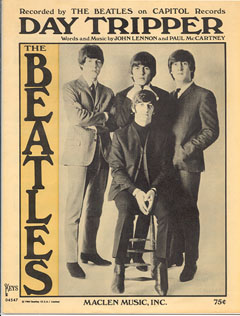 The first distinctive element of the song, not to mention the most notable, is the repeating two-measure guitar riff that begins the proceedings and is being played by George without any other instrumental backing, much like John’s riff in “You Can’t Do That.” But while the riff from that 1964 classic is used to form the framework of the song, the guitar riff in “Day Tripper” absolutely permeates the proceedings. It appears as the first thing and ultimately the last thing we hear in the song, this guitar figure endlessly repeating itself, even on top of changing chords. Not that we mind; I don’t think there is any argument that this guitar riff is the most identifiable and best-loved riff within the entire Beatles catalog, arguably in all of rock/pop music. The first distinctive element of the song, not to mention the most notable, is the repeating two-measure guitar riff that begins the proceedings and is being played by George without any other instrumental backing, much like John’s riff in “You Can’t Do That.” But while the riff from that 1964 classic is used to form the framework of the song, the guitar riff in “Day Tripper” absolutely permeates the proceedings. It appears as the first thing and ultimately the last thing we hear in the song, this guitar figure endlessly repeating itself, even on top of changing chords. Not that we mind; I don’t think there is any argument that this guitar riff is the most identifiable and best-loved riff within the entire Beatles catalog, arguably in all of rock/pop music.
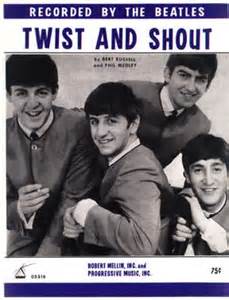 "The riff became one of our most well-known and you still often hear it played when you walk into guitar shops," Paul states in his book "The Lyrics." "It's one of those songs that revolves around the riff. Some songs are hung onto a chord progression. Others, like this, are driven by the riff. and does that Little Richard 'Lucille' thing of moving the pattern from one chord - in this case E - up to A, then over to B for the solo where the vocals work up the scale, building to a 'Twist And Shout' type crescendo. It has a blues kind of structure, but we got a bit inventive in the chorus with the chords." "The riff became one of our most well-known and you still often hear it played when you walk into guitar shops," Paul states in his book "The Lyrics." "It's one of those songs that revolves around the riff. Some songs are hung onto a chord progression. Others, like this, are driven by the riff. and does that Little Richard 'Lucille' thing of moving the pattern from one chord - in this case E - up to A, then over to B for the solo where the vocals work up the scale, building to a 'Twist And Shout' type crescendo. It has a blues kind of structure, but we got a bit inventive in the chorus with the chords."
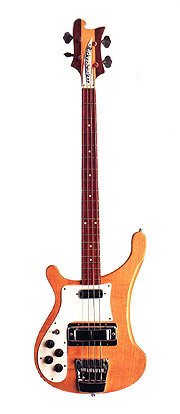 This ten-measure introduction is built around five repeats of the double-tracked guitar riff as the instrumentation builds behind it. After hearing it played solo, the third and fourth measure adds Paul’s bass playing the same riff, while the fifth through eighth measure has both John’s rhythm guitar and tambourine (overdubbed) join the fray. The second half of the eighth measure introduces Ringo with his excellent tom fills, more of which we’ll hear later. As the cymbal crashes and the drums settle into a rock beat on closed hi-hat, the riff is heard for the fifth time, completing a rather lengthy ten-measure intro. This ten-measure introduction is built around five repeats of the double-tracked guitar riff as the instrumentation builds behind it. After hearing it played solo, the third and fourth measure adds Paul’s bass playing the same riff, while the fifth through eighth measure has both John’s rhythm guitar and tambourine (overdubbed) join the fray. The second half of the eighth measure introduces Ringo with his excellent tom fills, more of which we’ll hear later. As the cymbal crashes and the drums settle into a rock beat on closed hi-hat, the riff is heard for the fifth time, completing a rather lengthy ten-measure intro.
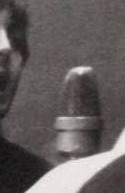 The first sixteen-measure verse then begins with Paul’s double-tracked lead vocals coming in directly on the downbeat (“Got a good reason”). With the guitar riff continuing, John’s double-tracked harmony vocals kick in for the third and fourth measures (“for taking the easy way out”), this vocal pattern continuing in the next four measures. The fifth measure shows the song finally shift away from its home key of E major to A major with the guitar riff following it, this seemingly indicating that we’ll be delving into another 12-bar blues pattern the group habitually uses, as heard in “You Can’t Do That” and “Can’t Buy Me Love,” as well as countless others. However, this is not the case. The group jumps to an unpredictable F# chord while the rhythm switches to an R&B-style beat with accents on all four quarter notes instead of just the two and four as heard up to this point. In his book “Revolution In The Head,” Ian MacDonald cites this change as “another in-joke…played with fours on the bass drum in the style of Al Jackson of the MGs, the Stax house band.” The first sixteen-measure verse then begins with Paul’s double-tracked lead vocals coming in directly on the downbeat (“Got a good reason”). With the guitar riff continuing, John’s double-tracked harmony vocals kick in for the third and fourth measures (“for taking the easy way out”), this vocal pattern continuing in the next four measures. The fifth measure shows the song finally shift away from its home key of E major to A major with the guitar riff following it, this seemingly indicating that we’ll be delving into another 12-bar blues pattern the group habitually uses, as heard in “You Can’t Do That” and “Can’t Buy Me Love,” as well as countless others. However, this is not the case. The group jumps to an unpredictable F# chord while the rhythm switches to an R&B-style beat with accents on all four quarter notes instead of just the two and four as heard up to this point. In his book “Revolution In The Head,” Ian MacDonald cites this change as “another in-joke…played with fours on the bass drum in the style of Al Jackson of the MGs, the Stax house band.”
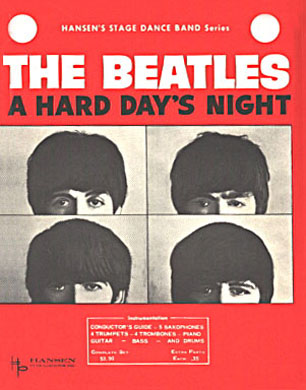 At this point in the song, Lennon appears to have switched to lead vocalist with Paul singing the higher harmony joined by George for three part harmony. Since John is the primary writer of the song and it was customary for Paul to sing lead on lines that were a little out of John’s reach (see “A Hard Day’s Night” and “Any Time At All”), this can confidently be said to be the case here as well. Then the melody line and chord pattern cascades downward while unpredictable chord changes occur, only to land firmly back on the home key of E major for the second verse. At this point in the song, Lennon appears to have switched to lead vocalist with Paul singing the higher harmony joined by George for three part harmony. Since John is the primary writer of the song and it was customary for Paul to sing lead on lines that were a little out of John’s reach (see “A Hard Day’s Night” and “Any Time At All”), this can confidently be said to be the case here as well. Then the melody line and chord pattern cascades downward while unpredictable chord changes occur, only to land firmly back on the home key of E major for the second verse.
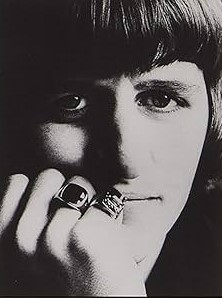 One interesting observation during the second half of this verse (referred to by some as the chorus) is that while the guitar riff is finally put on hiatus, the bass continues to play a pattern that resembles it. This keeps the essence of the riff playing in the back of our mind (as if we would have forgotten it). Also, Ringo curiously includes a rapid-fire sixteenth-note figure on the two-beat of both the thirteenth and fourteenth measures during the words “so long.” Since he repeats the same thing in the other two verses, as well as the previous takes of the song, this was indeed planned. One interesting observation during the second half of this verse (referred to by some as the chorus) is that while the guitar riff is finally put on hiatus, the bass continues to play a pattern that resembles it. This keeps the essence of the riff playing in the back of our mind (as if we would have forgotten it). Also, Ringo curiously includes a rapid-fire sixteenth-note figure on the two-beat of both the thirteenth and fourteenth measures during the words “so long.” Since he repeats the same thing in the other two verses, as well as the previous takes of the song, this was indeed planned.
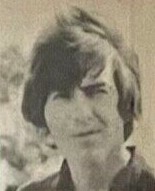 The second verse actually contains its own introduction, this being a four-measure re-introduction of the guitar riff which is obviously their intended focal point for the song. The first two measures consist of a break in all instrumentation except for George’s double-tracked riff and John’s double-tracked tambourine shaking. Ringo reprises his tom roll and cymbal crash to usher in the rest of the rhythm section and to thereby finish off the second two measures of this intro. The second verse actually contains its own introduction, this being a four-measure re-introduction of the guitar riff which is obviously their intended focal point for the song. The first two measures consist of a break in all instrumentation except for George’s double-tracked riff and John’s double-tracked tambourine shaking. Ringo reprises his tom roll and cymbal crash to usher in the rest of the rhythm section and to thereby finish off the second two measures of this intro.
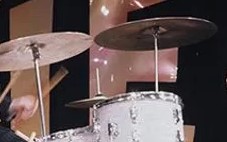 The second verse now continues with the same exact arrangement as the first except for different lyrics in the first eight measures. This verse ends with Paul exclaiming “hey” off microphone on one of his vocal tracks while a cymbal crash ushers in the 12-measure bridge, which listeners understandably identify as the “solo” of the song. Not heard before in any Beatles song, the group uses this opportunity to build the arrangement into a blistering climax, changing the key to B and altering the guitar riff to accommodate the change. The second verse now continues with the same exact arrangement as the first except for different lyrics in the first eight measures. This verse ends with Paul exclaiming “hey” off microphone on one of his vocal tracks while a cymbal crash ushers in the 12-measure bridge, which listeners understandably identify as the “solo” of the song. Not heard before in any Beatles song, the group uses this opportunity to build the arrangement into a blistering climax, changing the key to B and altering the guitar riff to accommodate the change.
 The first six measures consist of the riff being played three times while Ringo crashes the cymbal on every downbeat. The B chord may be played nonstop throughout all of these measures, but the illusion of rising chords is given by a single note being played by George on the two-beat of each measure on the rhythm track, each measure ascending one note higher on the scale. Add to this the double-tracked ascending harmonies from Lennon and McCartney in measures seven through twelve with Ringo reverting to the Stax-like accented drumming beginning in the seventh measure while crashing away at his cymbals. The first six measures consist of the riff being played three times while Ringo crashes the cymbal on every downbeat. The B chord may be played nonstop throughout all of these measures, but the illusion of rising chords is given by a single note being played by George on the two-beat of each measure on the rhythm track, each measure ascending one note higher on the scale. Add to this the double-tracked ascending harmonies from Lennon and McCartney in measures seven through twelve with Ringo reverting to the Stax-like accented drumming beginning in the seventh measure while crashing away at his cymbals.
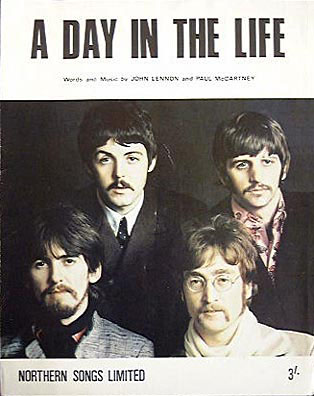 All the while, George reverts to a pedal-point overdubbed guitar rhythm while a further lead guitar part appears on top as another overdub, adding even more to the thickness of the sound. As the harmonies ascend to a feverish pitch in the final three measures, Ringo just blasts away, accenting every eighth note on his snare and crash cymbal. Given the sexual content of the lyrics, “climax” is the only appropriate word to be used here to describe The Beatles intent. Only the orchestral build in “A Day In The Life” can be said to upstage the intended effect of the bridge in “Day Tripper.” All the while, George reverts to a pedal-point overdubbed guitar rhythm while a further lead guitar part appears on top as another overdub, adding even more to the thickness of the sound. As the harmonies ascend to a feverish pitch in the final three measures, Ringo just blasts away, accenting every eighth note on his snare and crash cymbal. Given the sexual content of the lyrics, “climax” is the only appropriate word to be used here to describe The Beatles intent. Only the orchestral build in “A Day In The Life” can be said to upstage the intended effect of the bridge in “Day Tripper.”
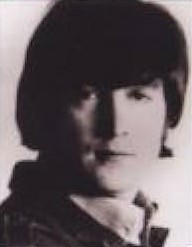 Finally, we’re back on solid ground as we hear the band suddenly stop to reveal the solo guitar riff once again, this being a repeat of the verse intro we heard before verse two. The third verse is also identical in instrumentation and structure but with yet a new set of lyrics in the first eight measures. A slight alteration is also heard in the eleventh measure, “Sunday driver” substituted for “one-way ticket” (John accidentally combining the two on one of his vocal tracks). The words “so long” are now sung in falsetto to add some nice variation from the previous verses. Finally, we’re back on solid ground as we hear the band suddenly stop to reveal the solo guitar riff once again, this being a repeat of the verse intro we heard before verse two. The third verse is also identical in instrumentation and structure but with yet a new set of lyrics in the first eight measures. A slight alteration is also heard in the eleventh measure, “Sunday driver” substituted for “one-way ticket” (John accidentally combining the two on one of his vocal tracks). The words “so long” are now sung in falsetto to add some nice variation from the previous verses.
 A full repeat of the song’s introduction is now heard which culminates in the conclusion and fade of the track. As the tambourine part finishes off the eighth measure, it begins to rush the tempo, this making it sound as if Ringo was late coming in with his tom roll. When listening to the rhythm track alone (aka, the left channel of the original stereo mix), you’ll see that Ringo’s time was impeccable as usual, John not being able to keep accurate time while overdubbing the tambourine without Ringo’s drum beat there as a guide. A full repeat of the song’s introduction is now heard which culminates in the conclusion and fade of the track. As the tambourine part finishes off the eighth measure, it begins to rush the tempo, this making it sound as if Ringo was late coming in with his tom roll. When listening to the rhythm track alone (aka, the left channel of the original stereo mix), you’ll see that Ringo’s time was impeccable as usual, John not being able to keep accurate time while overdubbing the tambourine without Ringo’s drum beat there as a guide.
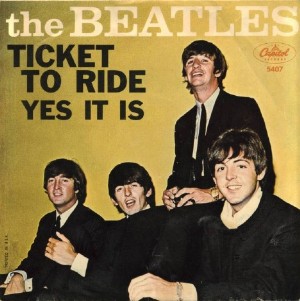 After Ringo's cymbal crash on the downbeat of the eighth measure, the band kicks in with John and Paul altering final lyrical phrases “day tripper” and “day tripper, yeah” as Ringo reprises his triplet beats from “Ticket To Ride” in between (as well as one last tom roll in the twelfth measure). So ends a classic piece of rock’n’roll history. After Ringo's cymbal crash on the downbeat of the eighth measure, the band kicks in with John and Paul altering final lyrical phrases “day tripper” and “day tripper, yeah” as Ringo reprises his triplet beats from “Ticket To Ride” in between (as well as one last tom roll in the twelfth measure). So ends a classic piece of rock’n’roll history.
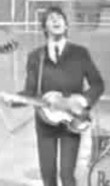 Every Beatle is in top form on this song, exuding the confidence of this brilliantly written track. John’s stunning vocal delivery is evident throughout as is his rhythm guitar performance and, uncharacteristic for him, tambourine work. Paul equally plays a prominent role, his voice being the first heard on "Day Tripper" leading listeners to view him as the main catalyst to its writing, although his input was no doubt substantial. Paul's bass playing, while mimicking the guitar riff in strategic places, is quite appropriate where it doesn’t. Every Beatle is in top form on this song, exuding the confidence of this brilliantly written track. John’s stunning vocal delivery is evident throughout as is his rhythm guitar performance and, uncharacteristic for him, tambourine work. Paul equally plays a prominent role, his voice being the first heard on "Day Tripper" leading listeners to view him as the main catalyst to its writing, although his input was no doubt substantial. Paul's bass playing, while mimicking the guitar riff in strategic places, is quite appropriate where it doesn’t.
George appears very much a part of the game, his guitar delivery well executed from beginning to end. And Ringo shines brilliantly with his sharp attention to detail in this razor sharp arrangement, this song being a true highlight in his Beatles career.
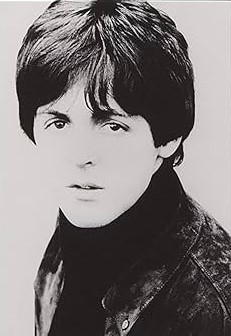 With this song written and recorded during the period where they thought, as McCartney explained it, “comedy numbers are the next thing…songs with jokes in,” the lyrical intent of “Day Tripper,” as outlined above under “Songwriting History,” comes through as more innuendo than storytelling. That being said, the singer is “taking the easy way out” of this relationship because she wasn’t all that he thought she was. Being only “a day tripper” and not committed to that lifestyle all of the time, he was no longer interested, although it took him “so long to find out.” Not that he didn’t give her a chance..after all, he “tried to please her.” Referring to their sexual relationship, she “only played one night stands,” but even then, she only took him “half the way there” anyway. It's no wonder he moved on. With this song written and recorded during the period where they thought, as McCartney explained it, “comedy numbers are the next thing…songs with jokes in,” the lyrical intent of “Day Tripper,” as outlined above under “Songwriting History,” comes through as more innuendo than storytelling. That being said, the singer is “taking the easy way out” of this relationship because she wasn’t all that he thought she was. Being only “a day tripper” and not committed to that lifestyle all of the time, he was no longer interested, although it took him “so long to find out.” Not that he didn’t give her a chance..after all, he “tried to please her.” Referring to their sexual relationship, she “only played one night stands,” but even then, she only took him “half the way there” anyway. It's no wonder he moved on.
 From examining this great song, which is more instrumentally based than lyrically, the obvious intent of “Day Tripper” as a whole was to focus on the music. While the lyrics did raise eyebrows in 1965 (as they may still today), the striking feature of the track is and will always be the instrumental delivery. Hum the guitar riff to people of most age groups and I’d venture to guess they’ll at least have a good guess as to what it's from. From examining this great song, which is more instrumentally based than lyrically, the obvious intent of “Day Tripper” as a whole was to focus on the music. While the lyrics did raise eyebrows in 1965 (as they may still today), the striking feature of the track is and will always be the instrumental delivery. Hum the guitar riff to people of most age groups and I’d venture to guess they’ll at least have a good guess as to what it's from.
 "Day Tripper" picture sleeve
|
American Releases
“Day Tripper” may have been earmarked to be their upcoming December 1965 single, but when the highly commercial “We Can Work It Out” was recorded shortly afterward, the consensus began to tip to its favor. John Lennon objected and, to appease his demand, both songs were released on the same single with equal billing; the first double a-side.
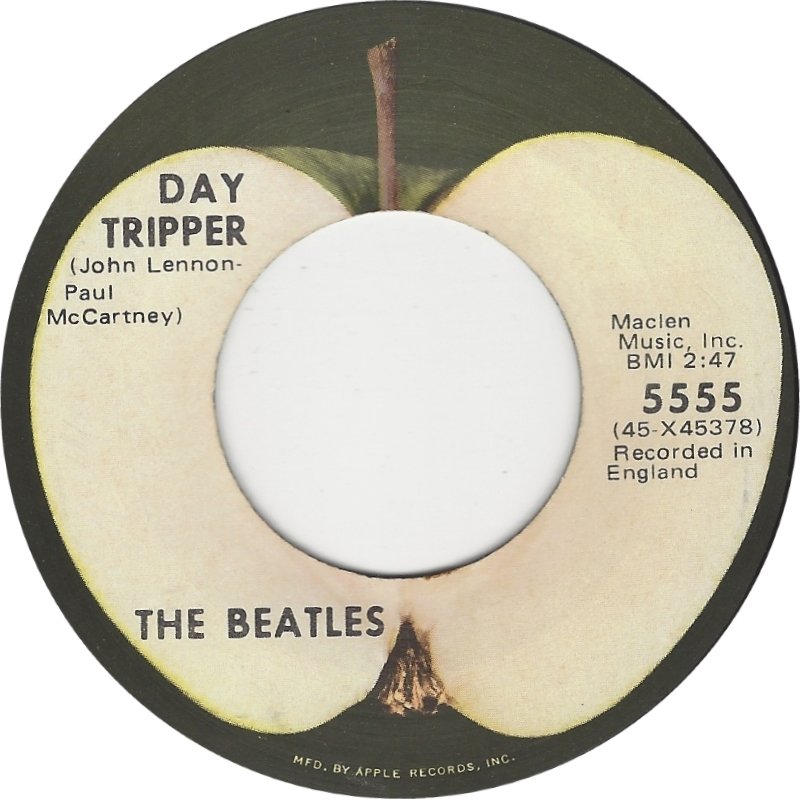 The British single showed both songs as a #1 hit, but the Billboard Hot 100 in America positioned each song individually. When the single was released by Capitol in the US on December 6th, 1965, “We Can Work It Out” topped the chart while “Day Tripper” peaked at the highly respectable #5 position on Billboard. Capitol even designated it as the b-side, giving it the higher index number 45-X45378, which meant that when it was issued on the Apple label in the '70s, “Day Tripper” appeared on the sliced apple side of the record. The British single showed both songs as a #1 hit, but the Billboard Hot 100 in America positioned each song individually. When the single was released by Capitol in the US on December 6th, 1965, “We Can Work It Out” topped the chart while “Day Tripper” peaked at the highly respectable #5 position on Billboard. Capitol even designated it as the b-side, giving it the higher index number 45-X45378, which meant that when it was issued on the Apple label in the '70s, “Day Tripper” appeared on the sliced apple side of the record.
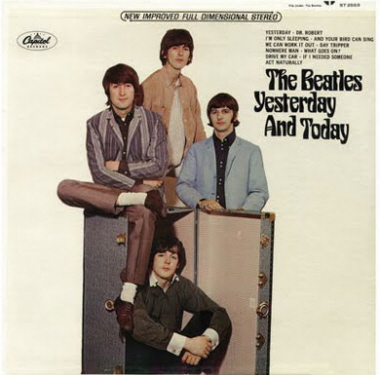 June 20th, 1966 was the release date of Capitol's album “Yesterday…And Today” which featured both sides of this December 1965 single, “Day Tripper” becoming the excellent closing number of the record. "Yesterday...And Today" was then released on January 21st, 2014, as an individual compact disc, both the mono and stereo versions of the album being included on the single CD. Incidentally, this release featured both the "trunk" cover and the "butcher" cover. June 20th, 1966 was the release date of Capitol's album “Yesterday…And Today” which featured both sides of this December 1965 single, “Day Tripper” becoming the excellent closing number of the record. "Yesterday...And Today" was then released on January 21st, 2014, as an individual compact disc, both the mono and stereo versions of the album being included on the single CD. Incidentally, this release featured both the "trunk" cover and the "butcher" cover.
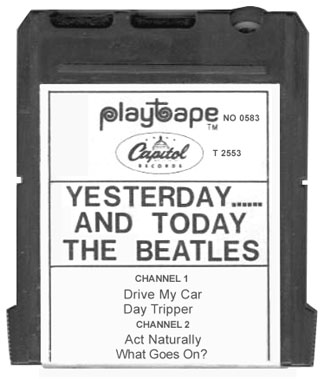 Sometime in 1967, Capitol released Beatles music on a brand new but short-lived format called "Playtapes." These tape cartridges did not have the capability to include entire albums, so two truncated four-song versions of "Yesterday...And Today" were released in this portable format, "Day Tripper" being on one of them. These "Playtapes" are highly collectable today. Incidentally, "Day Tripper" was unfortunately divided in half on its appearance on the eight-track version of "Yesterday...And Today" also released in 1967, the first half of the song appearing on channel three with the remainder starting out channel four. Sometime in 1967, Capitol released Beatles music on a brand new but short-lived format called "Playtapes." These tape cartridges did not have the capability to include entire albums, so two truncated four-song versions of "Yesterday...And Today" were released in this portable format, "Day Tripper" being on one of them. These "Playtapes" are highly collectable today. Incidentally, "Day Tripper" was unfortunately divided in half on its appearance on the eight-track version of "Yesterday...And Today" also released in 1967, the first half of the song appearing on channel three with the remainder starting out channel four.
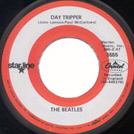 Sometime in 1969, the original single was accidently printed in a limited edition on the Capitol Star Line label, the mistake being made at the facory in Jacksonville, Illinois. This disc has reportedly become the most collectible and valuable of all Capitol Beatles singles in existence. Sometime in 1969, the original single was accidently printed in a limited edition on the Capitol Star Line label, the mistake being made at the facory in Jacksonville, Illinois. This disc has reportedly become the most collectible and valuable of all Capitol Beatles singles in existence.
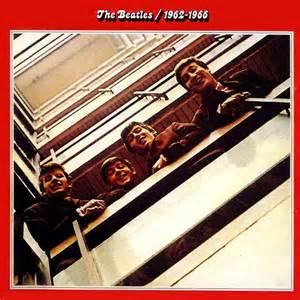 The first official American compilation album, “The Beatles/1962-1966” (“The Red Album”), was released on April 2nd, 1973. The first stereo mix of the song “Day Tripper,” as had appeared on “Yesterday…And Today,” was included on the vinyl edition at that time. However, when the album came out on compact disc in 1993, and then remastered on August 10th, 2010, the later stereo mix from 1966 replaced it. The first official American compilation album, “The Beatles/1962-1966” (“The Red Album”), was released on April 2nd, 1973. The first stereo mix of the song “Day Tripper,” as had appeared on “Yesterday…And Today,” was included on the vinyl edition at that time. However, when the album came out on compact disc in 1993, and then remastered on August 10th, 2010, the later stereo mix from 1966 replaced it.
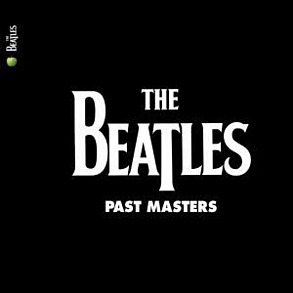 On March 7th, 1988, the CD “Past Masters, Volume Two” was released, this featuring “Day Tripper” as its opening track. Since the later stereo mix from 1966 was included on this release, the 1965 stereo mix was deemed obsolete as of this date. However, the flaws in the final verse were fixed so that there were no gaps in the guitar passages as originally heard in the mix. Both volumes of "Past Masters" were combined into a double-album for its vinyl release on October 24th, 1988. This continued as a double-album set when it was remastered and re-released on CD on September 9th, 2009 and on vinyl on November 12th, 2012. On March 7th, 1988, the CD “Past Masters, Volume Two” was released, this featuring “Day Tripper” as its opening track. Since the later stereo mix from 1966 was included on this release, the 1965 stereo mix was deemed obsolete as of this date. However, the flaws in the final verse were fixed so that there were no gaps in the guitar passages as originally heard in the mix. Both volumes of "Past Masters" were combined into a double-album for its vinyl release on October 24th, 1988. This continued as a double-album set when it was remastered and re-released on CD on September 9th, 2009 and on vinyl on November 12th, 2012.
January 24th, 1996 was the date that the original single was re-released on the Capitol Cema Series “For Jukeboxes Only” on pink vinyl, which is quite the collectors’ item today.
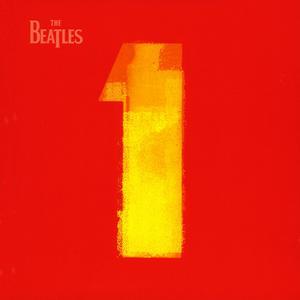 Since both sides of the single were considered #1 hits in the UK, “Day Tripper” was also included on the November 13th, 2000 released CD “Beatles 1." A remastered version of this album was released in September of 2011 and a newly mixed version was released on November 6th, 2015. Since both sides of the single were considered #1 hits in the UK, “Day Tripper” was also included on the November 13th, 2000 released CD “Beatles 1." A remastered version of this album was released in September of 2011 and a newly mixed version was released on November 6th, 2015.
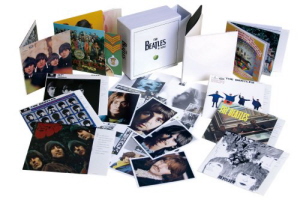 On September 9th, 2009, the remastered CD box set “The Beatles In Mono” was released which featured “Day Tripper” on the new disc “Mono Masters” that was included therein. Also released on September 9th, 2009, in promotion of the remastered Beatles catalog, the "09.09.09 Sampler" was given out to retailers and radio programmers, "Day Tripper" being featured therein. The vinyl edition of the box set was first released on September 9th, 2014. On September 9th, 2009, the remastered CD box set “The Beatles In Mono” was released which featured “Day Tripper” on the new disc “Mono Masters” that was included therein. Also released on September 9th, 2009, in promotion of the remastered Beatles catalog, the "09.09.09 Sampler" was given out to retailers and radio programmers, "Day Tripper" being featured therein. The vinyl edition of the box set was first released on September 9th, 2014.
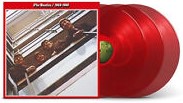 A new 50th Anniversay edition of the compilation album "The Beatles / 1962 - 1966" (aka "The Red Album") was released on November 10th, 2023, the newly created AI stereo mix of "Day Tripper" detailed above being featured here. This expanded set included 12 additional songs for a total of 38 tracks, and was made available as a double CD and as a triple vinyl release on both black and red vinyl. A new 50th Anniversay edition of the compilation album "The Beatles / 1962 - 1966" (aka "The Red Album") was released on November 10th, 2023, the newly created AI stereo mix of "Day Tripper" detailed above being featured here. This expanded set included 12 additional songs for a total of 38 tracks, and was made available as a double CD and as a triple vinyl release on both black and red vinyl.
A live Paul McCartney version of the song recorded in July of 2009 at Citi Field in New York City was made available on his “Good Evening New York City” album. This triple disc set (2 CD, 1 DVD) was released on November 17th, 2009.
Live Performances
 On November 1st and 2nd, 1965, The Beatles were in Studio Six at Granada TV Centre in Manchester, England to film the upcoming British TV special “The Music Of Lennon And McCartney.” The group's job was to lip-sync both sides of their soon-to-be-released single, “Day Tripper” being one of them. This segment begins with six girls in black mini-skirts and sunglasses dancing to the intro of the song. Just as the first verse begins, they run through the background of where The Beatles are performing. Interesting things to look for include Ringo ending the bridge/solo section of the song one measure too early and the group bowing and comically gesturing to an imaginary audience at the end of the song, the audience applause being dubbed in later. On November 1st and 2nd, 1965, The Beatles were in Studio Six at Granada TV Centre in Manchester, England to film the upcoming British TV special “The Music Of Lennon And McCartney.” The group's job was to lip-sync both sides of their soon-to-be-released single, “Day Tripper” being one of them. This segment begins with six girls in black mini-skirts and sunglasses dancing to the intro of the song. Just as the first verse begins, they run through the background of where The Beatles are performing. Interesting things to look for include Ringo ending the bridge/solo section of the song one measure too early and the group bowing and comically gesturing to an imaginary audience at the end of the song, the audience applause being dubbed in later.
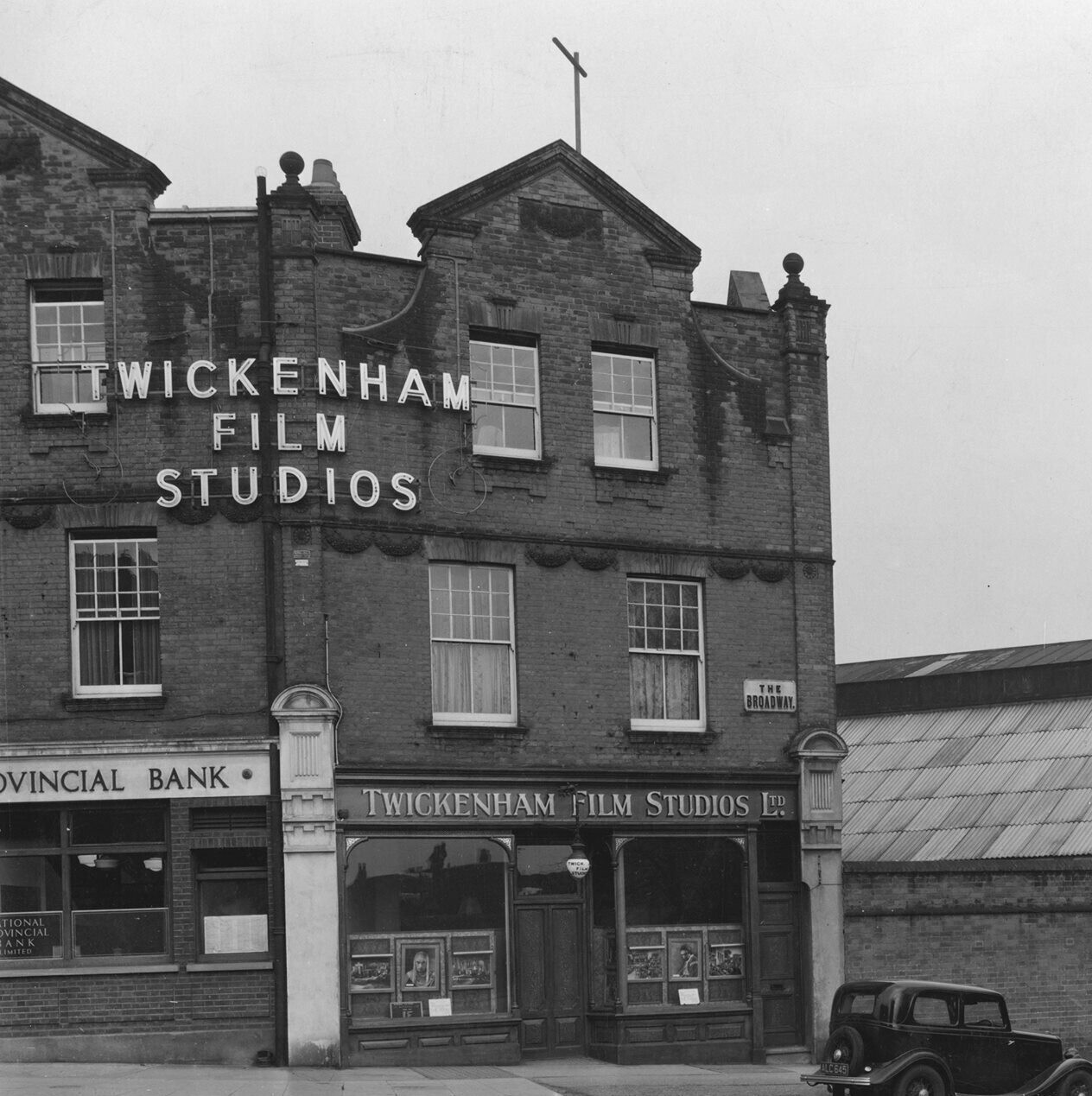 Recognizing the great advantages of filming segments to be used for TV shows instead of appearing in person, The Beatles arranged to continue this practice by filming lip-synced performances of their more recent releases at Twickenham Film Studios on November 23rd, 1965. Three versions of “Day Tripper” were filmed. The first had George and Ringo standing behind an old-fashioned train car prop with Ringo switching from shaking a tambourine to playing "air drums" with a pair of drum sticks. Meanwhile, Paul and John were a few feet away behind a prop consisting of two airplanes. They were all wearing their suits famously known from their Shea Stadium performance on August 15th of that year. Ringo on two occasions reveals a saw and proceeds to attempt cutting the cardboard prop he is standing behind. Recognizing the great advantages of filming segments to be used for TV shows instead of appearing in person, The Beatles arranged to continue this practice by filming lip-synced performances of their more recent releases at Twickenham Film Studios on November 23rd, 1965. Three versions of “Day Tripper” were filmed. The first had George and Ringo standing behind an old-fashioned train car prop with Ringo switching from shaking a tambourine to playing "air drums" with a pair of drum sticks. Meanwhile, Paul and John were a few feet away behind a prop consisting of two airplanes. They were all wearing their suits famously known from their Shea Stadium performance on August 15th of that year. Ringo on two occasions reveals a saw and proceeds to attempt cutting the cardboard prop he is standing behind.
 The remaining two promo films shot on this day show them dressed in black shirts and/or turtlenecks and positioned in a usual band formation. Both videos are primarily identical, the only recognizable difference being Ringo's movements during times when he isn’t playing the drums. The remaining two promo films shot on this day show them dressed in black shirts and/or turtlenecks and positioned in a usual band formation. Both videos are primarily identical, the only recognizable difference being Ringo's movements during times when he isn’t playing the drums.
 Their final British tour commenced on December 3rd, 1965, in Glasgow and only lasted until December 12th in Cardiff, including their final Liverpool performances on December 5th, 1965 at the Empire Theatre. With the single newly released, “Day Tripper” was highlighted as the next-to-last song in their brief eleven song set list. Their final British tour commenced on December 3rd, 1965, in Glasgow and only lasted until December 12th in Cardiff, including their final Liverpool performances on December 5th, 1965 at the Empire Theatre. With the single newly released, “Day Tripper” was highlighted as the next-to-last song in their brief eleven song set list.
 The Beatles' next live appearance wasn’t until May 1st, 1966 at the Empire Pool in Wembley for the “New Musical Express Annual Poll-Winners’ All Star Concert.” The group performed five songs, including the crowd pleaser “Day Tripper” as the third song. Because of contractual disagreements, the show was not taped and broadcast on British television as it had been in previous years. The Beatles' next live appearance wasn’t until May 1st, 1966 at the Empire Pool in Wembley for the “New Musical Express Annual Poll-Winners’ All Star Concert.” The group performed five songs, including the crowd pleaser “Day Tripper” as the third song. Because of contractual disagreements, the show was not taped and broadcast on British television as it had been in previous years.
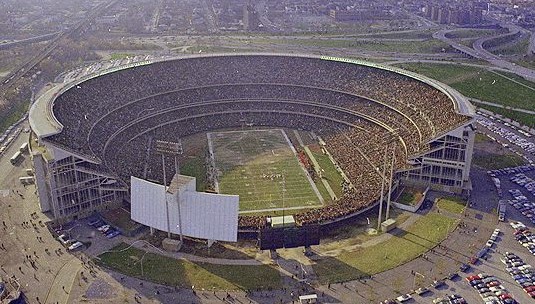 June 24th, 1966 was the kickoff date of their final brief international tour, which began in West Germany and eventually reached Japan and then The Philippines on July 4th of that year. With “Day Tripper” as the fourth in their small eleven song set list, they continued to use this exact group of songs for their last American tour which stretched from August 12th through 29th, 1966. Stopping off in Chicago, Detroit, Cleveland, Cincinnati and New York City (a second Shea Stadium appearance) among other cities, they ended their final tour at Candlestick Park in San Francisco with “Day Tripper” prominently displayed. June 24th, 1966 was the kickoff date of their final brief international tour, which began in West Germany and eventually reached Japan and then The Philippines on July 4th of that year. With “Day Tripper” as the fourth in their small eleven song set list, they continued to use this exact group of songs for their last American tour which stretched from August 12th through 29th, 1966. Stopping off in Chicago, Detroit, Cleveland, Cincinnati and New York City (a second Shea Stadium appearance) among other cities, they ended their final tour at Candlestick Park in San Francisco with “Day Tripper” prominently displayed.
 Undoubtedly because this song was primarily written by and known as a Lennon composition, Paul declined to perform “Day Tripper” throughout his later touring years. This all changed, though, in 2009 with his “Summer Live ‘09” tour, which ran from July 11th through August 19th of that year. The song was the first performed during his first encore. His “Good Evening Europe” tour, which ran from December 2nd to 22nd of that year, also included the song in his first encore. Then, his “Up And Coming Tour,” which ran from March 28th, 2010 to June 10th, 2011, also included the song near the end of the set list, as did his "On The Run" tour, this spanning from July 15th, 2011 to November 29th, 2012 at Rexall Place in Edmondton, Canada. After that, his "Out There!" tour, which spanned from May 4th to October 22nd, 2015, featured the song, as well as some of the 2023 leg of his "Got Back" tour, which stretched from October 18th to December 16th of that year. Undoubtedly because this song was primarily written by and known as a Lennon composition, Paul declined to perform “Day Tripper” throughout his later touring years. This all changed, though, in 2009 with his “Summer Live ‘09” tour, which ran from July 11th through August 19th of that year. The song was the first performed during his first encore. His “Good Evening Europe” tour, which ran from December 2nd to 22nd of that year, also included the song in his first encore. Then, his “Up And Coming Tour,” which ran from March 28th, 2010 to June 10th, 2011, also included the song near the end of the set list, as did his "On The Run" tour, this spanning from July 15th, 2011 to November 29th, 2012 at Rexall Place in Edmondton, Canada. After that, his "Out There!" tour, which spanned from May 4th to October 22nd, 2015, featured the song, as well as some of the 2023 leg of his "Got Back" tour, which stretched from October 18th to December 16th of that year.
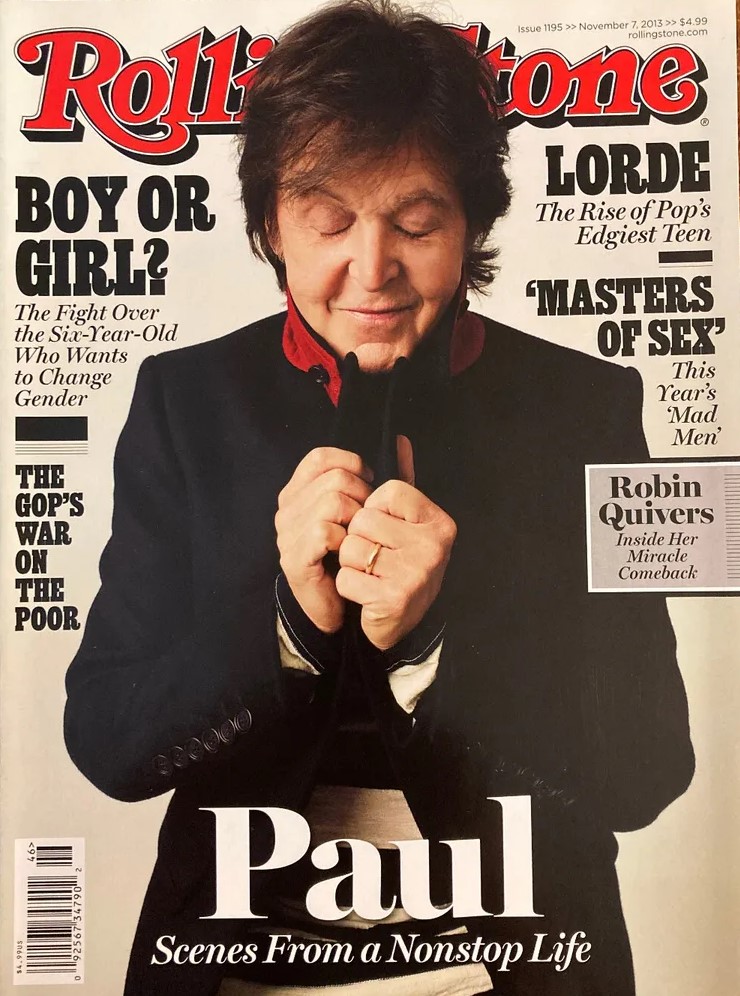 In a 2013 interview with Rolling Stone magazine, McCartney explained the difficulty in playing the song live. “I thought, ‘I just can't do it.’ It's like patting your head and rubbing your belly at the same time. It's not that easy to do. You've got to practice up on that. I goofed it a million times in rehearsal. Then, finally, I just thought, ‘OK, wait a minute, I'll do that…’ And I worked out how I was going to do it. So it's great for me, reviewing the past, and just thinking, ‘This is cool.’ It's still up-to-date. The combination of all of that makes it quite a joy to do.” In a 2013 interview with Rolling Stone magazine, McCartney explained the difficulty in playing the song live. “I thought, ‘I just can't do it.’ It's like patting your head and rubbing your belly at the same time. It's not that easy to do. You've got to practice up on that. I goofed it a million times in rehearsal. Then, finally, I just thought, ‘OK, wait a minute, I'll do that…’ And I worked out how I was going to do it. So it's great for me, reviewing the past, and just thinking, ‘This is cool.’ It's still up-to-date. The combination of all of that makes it quite a joy to do.”
Conclusion
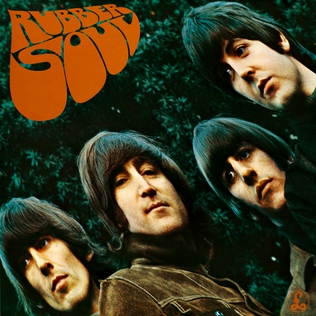 With the advent of “folk rock” being as prominent on the scene as it was in 1965, The Beatles took to exemplifying this much loved trend in the recording studio for their final album of that year. “Rubber Soul” was their most acoustic guitar-based album up to that time, not featuring any all-out rockers even when electric guitars were put to the fore. With the advent of “folk rock” being as prominent on the scene as it was in 1965, The Beatles took to exemplifying this much loved trend in the recording studio for their final album of that year. “Rubber Soul” was their most acoustic guitar-based album up to that time, not featuring any all-out rockers even when electric guitars were put to the fore.
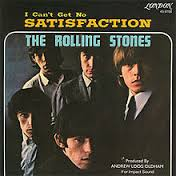 However, during these sessions, “Day Tripper” was the absolute quintessential rock song, blistering from beginning to end. While it maybe wouldn’t have fit comfortably on the “Rubber Soul” album, that wasn’t what it was intended for in the first place. They knew it would make a big splash as a non-album hit single. Marking for many the hallmark of their “middle period,” “Day Tripper” one-ups The Rolling Stones’ “Satisfaction,” The Kinks’ “All Day And All Of The Night” and The Who’s “Can’t Explain” in an attempt to prove that nobody can out-rock The Beatles. However, during these sessions, “Day Tripper” was the absolute quintessential rock song, blistering from beginning to end. While it maybe wouldn’t have fit comfortably on the “Rubber Soul” album, that wasn’t what it was intended for in the first place. They knew it would make a big splash as a non-album hit single. Marking for many the hallmark of their “middle period,” “Day Tripper” one-ups The Rolling Stones’ “Satisfaction,” The Kinks’ “All Day And All Of The Night” and The Who’s “Can’t Explain” in an attempt to prove that nobody can out-rock The Beatles.
Song Summary
“Day Tripper”
Written by: John Lennon / Paul McCartney
-
Song Written: September - October, 1965
-
Song Recorded: October 16, 1965
-
First US Release Date: December 6, 1965
-
US Single Release: Capitol #5555
-
Highest Chart Position: #5
-
-
British Album Release: Parlophone #PCS 7016 “A Collection Of Beatles Oldies”
-
Length: 2:47
-
Key: E major
-
Producer: George Martin
-
Engineers: Norman Smith, Ken Scott
Instrumentation (most likely):
-
John Lennon - Lead and Harmony Vocals, Rhythm Guitar (1964 Rickenbacker 235), tambourine
-
Paul McCartney - Lead and Harmony Vocals, Bass Guitar (1964 Rickenbacker 4001S)
-
George Harrison – Lead Guitar (1961 Sonic Blue Fender Stratocaster), Harmony Vocals
-
Ringo Starr – Drums (1965 Ludwig Super Classic Black Oyster Pearl)
Written and compiled by Dave Rybaczewski
|
IF YOU WOULD LIKE TO MAKE A DONATION TO KEEP THIS WEBSITE UP AND RUNNING, PLEASE CLICK BELOW!
Sign Up Below for our MONTHLY BEATLES TRIVIA QUIZ!
|